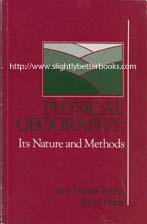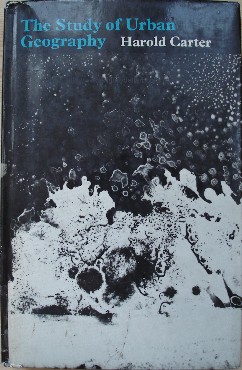

Slightly Better Books
Category Focus:
Geography
 |
Home | Contact | About Us |  |
|||||||||||||||||||||||||||||
|
|||||||||||||||||||||||||||||||||
| |
|||||||||||||||||||||||||||||||||
| Geography | ||
| In Pictures: | ****Hyperlinked titles will take you to our copy on sale or prebuilt searches of copies on sale**** Useful Links: Titles to Look Out For: |
On Amazon: |
![Crawford, S. 'Geography Three: Man Organises [The Developing World], published in 1972 (second impression) by Longman, paperback, 96pp, ISBN 0582200334. Condition: Very good nice clean copy, with previous owning organisation's stamp and classification number just inside the cover. Price: £3.25, not including p&p, which is Amazon's standard charge (currently £2.75 for UK buyers, more for overseas customers)](docs/crawfordsgeography3manorganises.jpg) 1972, Longman, pbk In stock, click to buy for £1.25 (not including p&p) Alternative online retailers to try: Or click here to access our prebuilt search for this title on Alibris Or click here to access our prebuilt search for this title on Ebay
|
About the Book: Written in the 1970s, this book is the third in a series of Geography books aimed at a broad range of ability in secondary schools (in the 1970s). The Developing World series also looks at history, religion and science. Despite some information now being out of date, the books contain a lot of useful information and covers highly-pertinent topic areas. The questions asked of the student in the tasks are still highly relevant and will still have the desired outcome of making today's student think about the issues presented to them. The text has a lively vocabulary, and the instructions and structured research outlines enable children to progress independently. All the units encourage the pupil to enter into problem-solving situations and to deduce man's solutions: all the work is based on the concept of learning through active discovery and participation. The books were written to cover the requirements of the secondary school up to the examination year. Each book was designed as an entity in itself, but with strong links forward and backward to other volumes. This volume emphasises the great benefits man gains from cooperative effort and illustrates the different methods by which communities and organisations have come to terms with their environment. It includes an integrated scheme of weather studies for each project. The illustrated narrative is broken at regular intervals by short tasks such as writing letters to organisations or discussing questions posed by the book. Following this is a considerable section headed Ideas to Develop in which the pupil's individual effort is encouraged. These sections include work in Living Language, Facts and Figures, Art and Craft, as well as Mapwork, Research, and Discussion Themes. An intelligent pupil will find material to challenge him or herself, whilst the slower pupil will not be discouraged. The books is designed to be an aid to the teacher, not to reduce his or her importance. The great range of ideas, activities and projects provided means that pupils can be fully occupied while the teacher gives individual and group attention when and where it is necessary. To help in the planning of work, the appendices contain lists of visual aids, book lists and addresses. With their help, the teacher will be able to make Geography a colourful and stimulating study. Contents: 2. Land from the Sea 3. Community Development in India 4. Communes in China 5. Plantations in Africa 6. The People of Israel 7. The Wealth of Kuwait 8. The Giant Corporation Review; Useful Addresses; Visual Aids; Library List; Index; To the Teacher |
The Developing World |
 1986, Paul Chapman Publishing, pbk In stock, click to buy for £12.00, not including post and packing, which is Amazon UK's standard charge (£2.80 for UK buyers) Alternative online retailers to try: Click here to access our prebuilt search for this title on Alibris
|
About this book: "Why did almost nobody believe in the theory of continental drift before 1960, but why did almost everybody do so after 1970? How can we explain the presence of dry water courses in arid areas? Why is Darwin's theory of evolution more widely accepted than any other?" The answer to these questions rests upon an appreciation of scientific method. Arising from the authors' belief that physical geography, as currently taught and practiced, lacks the scientific rigour of related disciplines, 'Physical Geography: Its Nature and Methods' deals with the philosophical context of the subject. It is the first book for many years to examine the discipline critically, and analyses a wide range of neglected issues dealing with the relations between philosophy, methodology and practice. It has been written for students of physical geography who have done some science but little philosophy and attempts to provide what the authors consider to be a much needed framework for the understanding of scientific method and its application in physical geography. It is not intended to present a review of the discipline or a history, but examples are used from a wide range of problems in order to establish that the implications apply comprehensively The ideas expressed in this book are taken from the writings of many scientists and philosophers; it is intended that readers examine them critically and consider what is written and take and apply what is learnt. The chapters follow a sequence, but they are mostly self-contained and therefore some of the important points are repeated. The first part of the book covers modern ideas on the philosophy of science and highlights principal issues for scientific practice; the second deals with the critical rationalist tradition in relation to various aspects of practice, using case studies at each stage to explain and illustrate the issues. The authors conclude that there must be a conscious attempt to inject a critical tradition and to improve the methods used by physical geographers, and that this study of method is intensely pratical, involving as it does the acquisition and improvement of the skills of thinking and doing Contents: PART II: Practice: |
|
 1972, Edward Arnold In stock, click to buy for £5.75 (not including p&p) Alternative online retailers to try: Or click here to access our prebuilt search for this title on Alibris Or click here to access our prebuilt search for this title on Ebay
|
About the Author: At the time of publication, Professor Carter was Gregynog Professor of Human Geography at the University College of Wales, Aberystwyth About the Book: The author, Professor Carter, wrote this book specifically for the university student and the view this book propounds is formed from experience of teaching in Aberystwyth University and from contact and exchanges with fellow urban geographers in Britain and America. Preface 1. Introduction: the study of urban geography Notes on further reading 2. The Process of Urbanization 3. The Process of Urbanization: The Growth of The City System 4. Urban Functions and the Functional Classification of Towns 5. Central Place Functions and Central Place Theory 6. The Ranking of Towns and The Delimitation of Spheres of Influence 7. Some Problems Associated with Central Place Theory and The Distribution of Towns 8. The Analysis of Town Plan 9. Urban Land-Use: General Problems 10. The Central Business District 11. The Residential Areas of the City 12. The Rural-Urban Fringe 13. The Location of Industry in the City 14. The Relation Between Function and Form in Urban Geography 15. Conclusion |
�
Urbanization Urban Functions |
|
[top] | |
| [top] | ||